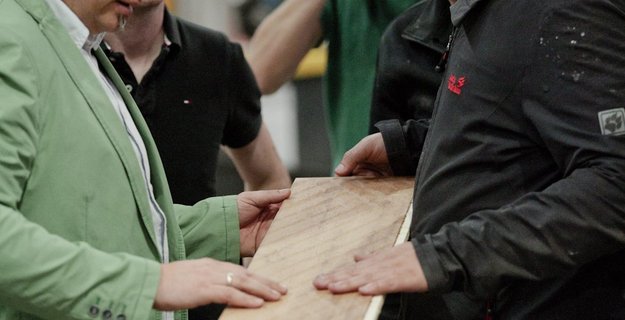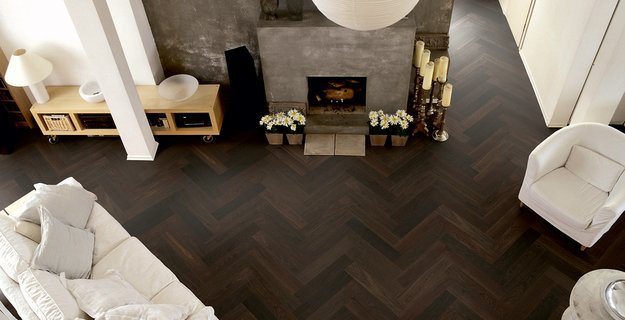![[Translate to EN:] Eiche country bianca](/fileadmin/_processed_/e/c/csm_woodflor140_182_222_eiche_country_bianca_valsega_wz-08_116920019816_115920019472_117920019755_rgb_aeb3a5e5ea.jpg)
Varnishing or oiling parquet flooring - which is better?
Should I opt for a lacquered or oiled parquet floor?
Multi-layer parquet always comes out of production with afinal finish; this means that no surface coatings need to be applied on site. Scheucher distinguishes between two types of coating: lacquer or oil. Both variants have advantages and disadvantages. Many customers face a challenge when making this decision: which surface finish should I choose?
To make this decision a little easier for you, we have summarized the most important information on the subject of lacquer and oil below.
The lacquered parquet floor
With the lacquered version, a layer of lacquer is applied to the surface at the end of the manufacturing process. This means that the parquet floor no longer needs to be treated after installation. The lacquer layer is hard and strong and protects the parquet floor optimally against liquids and dirt. Probably the biggest advantage of lacquered wood flooring is its high load-bearing capacity. The floor is extremely hard-wearing and is ideal for households with pets and/or children. In addition, the lacquered surface is ideal if there is a high footfall, for example in kitchens or entrance areas. If you are fitting out a restaurant with parquet flooring, a lacquered parquet floor is also always recommended here.
Another advantage of lacquered surfaces is that they are easy to handle: the floor does not need to be re-treated, a damp clean is all that is needed to protect the floor from dirt. The lacquered parquet floor is therefore much easier to maintain than an oiled surface.
![[Translate to EN:] Eiche astig natura](/fileadmin/_processed_/8/f/csm_multiflor2200.11_eiche_astig_natura_scheucher-177020027161_rgb_1ce403ef4a.jpg)
Looking at the disadvantages, it can be said that the floor loses in appearance and, above all, feel due to the full-surface sealing. The lacquered wooden floor never looks and feels as authentic as the oiled wooden floor. This can be counteracted by choosing a brushed version with a subsequent lacquer finish. This preserves the structure of the floor as much as possible. You can find a selection of our brushed & lacquered parquet floors here. Another disadvantage is the repair of damage. If there is a deep scratch or stain, it can be repaired with cleaning and care products. If this does not work, the plank must be replaced.
At Scheucher, you can choose between different lacquers: discover our parquet floors in TENSEO X-MATT and PUROTEC.
The oiled parquet floor
The oiled surface finish has become increasingly popular, especially in recent years, and for good reason! The oiled wooden floor feels real and can be clearly distinguished from laminate and PVC flooring. Visually, the oiled surface is a real eye-catcher and the wood is shown to its best advantage throughout. So what are the pros and cons of an oiled surface?
The oiled parquet floor is finished during the manufacturing process, i.e. the surface is oiled/waxed. Nevertheless, it is always advisable to carry out an initial treatment with oil on site after installation, as this provides optimum protection against dirt and moisture.
![[Translate to EN:] Eiche country natura](/fileadmin/_processed_/8/a/csm_multiflor2200.11_eiche_country_natura_scheucher-103220008426_rgb_98344c7074.jpg)
The oiled wooden floor is always open-pored, which means that the oil or wax is absorbed into the wood but does not close the pores. As a result, the structures are optimally preserved and the parquet flooring offers a unique feel that makes the walking experience special. If the floor is also brushed or planed, the so-called high-low structures come to the fore and the walking experience is further enhanced.
The oiled parquet floor is breathable, which has a positive effect on the room climate. Probably the biggest advantage of the oiled surface is that the floor is easy to repair. If there are deep scratches or stains, there are good options for repairing them, so there is usually no need to replace a plank.
However, there are also disadvantages to oiled parquet floors that need to be mentioned. First of all, the maintenance effort is significantly higher compared to the lacquered surface. The oiled wooden floor should be re-oiled every 1-3 years. The higher the footfall, the more often it is advisable to re-oil. This is important because the oil layer wears off over time; if this happens, dirt and moisture can penetrate the wooden floor. Furthermore, it is not advisable to choose an oiled surface in rooms subject to heavy traffic. For example, in entrance areas where people regularly walk with wet or dirty shoes, or in kitchens, the oiled surface should only be chosen if regular re-treatment (1-2 times a year!) can take place.
Scheucher offers a wide range of parquet floors with an oiled surface. Discover our top selection here.
Lacquered parquet flooring | Oiled parquet flooring |
Pores sealed | Open-pored |
Lacquer layer remains intact until sanding | Oil layer wears off over time |
Very hard-wearing | Unique feel |
Easy to maintain | Increased maintenance effort |
Repairs more difficult | Easy to repair |
Recommended for claimed areas | Recommended for bedrooms |



![[Translate to EN:] Eiche country natura Fischgrät](/fileadmin/_processed_/a/1/csm_bilaflor500_eiche_country_natura_fischgraet_wohnzimmer-6_7371_rgb_310f7549a6.jpg)
![[Translate to EN:] Nuss ami country](/fileadmin/_processed_/6/d/csm_woodflor182_nuss_ami_country_natura_sh-11036869_113010013427_rgb_e3cde0f435.jpg)
![[Translate to EN:] [Translate to EN:]](/fileadmin/_processed_/9/9/csm_planet-earth-surrounded-by-nature-vegetation_7f7902f211.jpg)